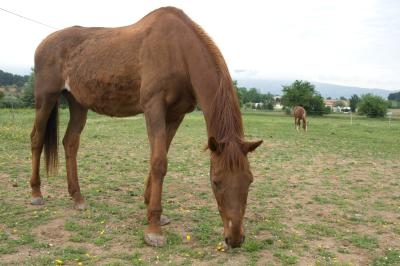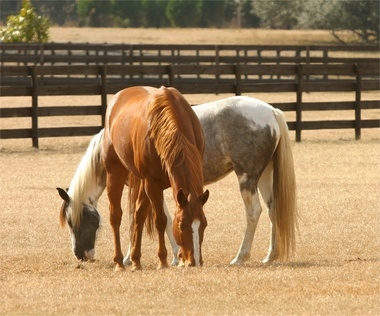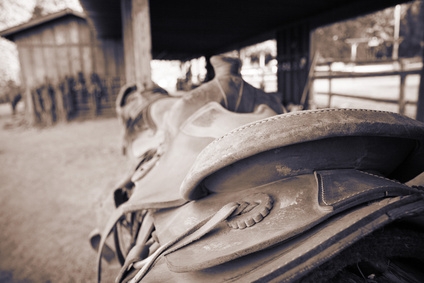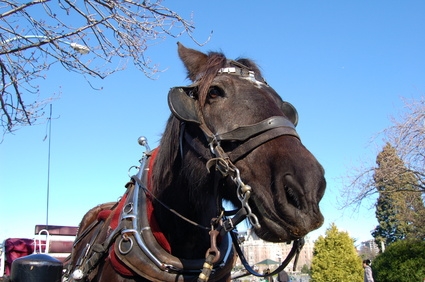Forage is the most important part of your horses diet, but who knew there were so many types? In order to make the right choice for your horses diet, its important to understand legume and grass hays and their nutritional value. Hopefully this will clarify the different types of common hay available.
Its important to remember that not all horses have the same nutrient needs, so naturally not all horses have the same hay needs. A hay that is suitable for a 10 year old Quarter Horse gelding used for trail riding may not be suitable for an 8 month old Thoroughbred. The best hay for any horse depends on the needs of that horse.
Alfalfa is one of most commonly fed legumes and is widely available in many parts of the country. A palatable hay that horses like the taste of, this is the hay often used to make cubes and pellets. Alfalfa is easy to digest and is an excellent source of protein and energy and provides more of them than grass hays. It is also produced and sold in every state. Pure alfalfa hay, as found in second cut hay, can have protein levels up to and exceeding 18 percent protein. . Adult horses require 10 to 11 percent crude protein in their overall diet, while growing horses require 12 to 14 percent so the high level of protein in alfalfa is not required for most horses, especially older horses.
The fiber content of most grass hays is relatively high. Orchard grass is common hay is not as sensitive to time of cutting with regards to end-stage nutrient content. While it is not as nutrient rich as alfalfa hay it has good flavor and is high in fiber. Timothy hay is easier on the digestive system than some of the others, with a high fiber and low calcium content. It can be more expensive, but the amount of in nutrients is good for old horses, young horses and lactating mares However, oat hay has thicker, tougher stalks than the other options available and some horses dont like the texture. It is hardy hay and seems to take a while for them to eat which makes it good for stall-bound horses. However, it can be higher in sugar and is not a good option for insulin resistant horses. Grass hays are lower in calories than legume hays and therefore are less likely to cause weight gain.
Grass hay provides the continual source of forage horses need for healthy digestion. Even the best grass hay cannot provide all of the nutrients a horse needs so you will likely need to feed additional concentrates and supplements. However, High grain intakes can be a risk factor in colic. Feed as much hay as possible. Also, diets with low levels of hay have also been related to an increased incidence of stall vices such as cribbing and wood chewing.
The biggest variable affecting nutrient content within a type of hay is the stage of maturity at harvest. Very early maturity hay often has a soft texture, is very leafy, and has a high nutrient density and palatability. Plants harvested in early maturity are cut soon after the seed heads emerge (grasses) or before the plant begins to bloom (legumes). Plants harvested in late maturity will have coarse, thick stems and less leaf than plants harvested in early maturity. The older the plant is at the time of harvest, the lower the nutrient value and the palatability.
Finally, the best hay for horses is clean hay. Hay that is moldy or dusty, even a little, should not be fed to horses. They can develop serious respiratory infections from dusty hay.

 How to Fatten an Underweight Horse Safely
How to Fatten an Underweight Horse Safely
How to Fatten an Underweight Horse Safely
How to Fatten an Underweight Horse Safely
 Horse Shelter Ideas
Horse Shelter Ideas
Horse Shelter Idea
Horse Shelter Ideas
Horse Shelter Ideas
Horse Shelter Idea
 How to Break a Horse to Ride
How to Break a Horse to Ride
How to Br
How to Break a Horse to Ride
How to Break a Horse to Ride
How to Br
 The Temperament of Gypsy Horses
The Temperament of Gypsy Horses
The Te
The Temperament of Gypsy Horses
The Temperament of Gypsy Horses
The Te
 How to Put Weight on a Horse Fast
How to Put Weight on a Horse Fast
How
How to Put Weight on a Horse Fast
How to Put Weight on a Horse Fast
How